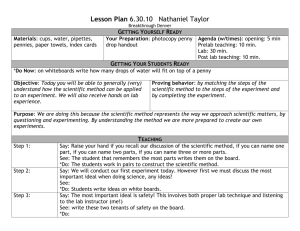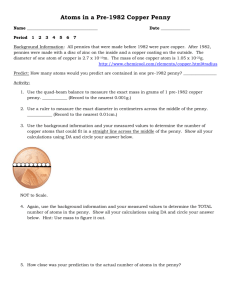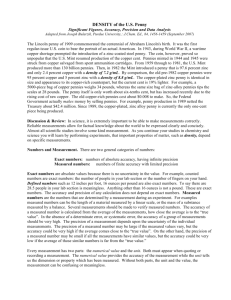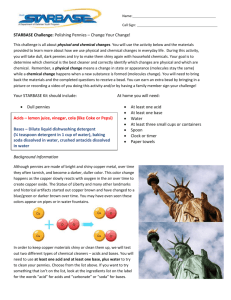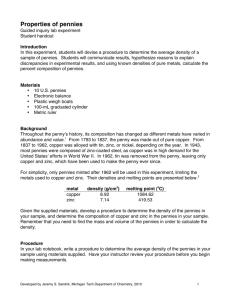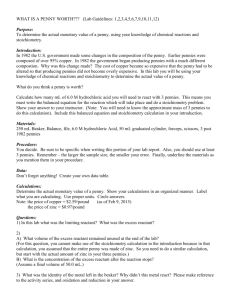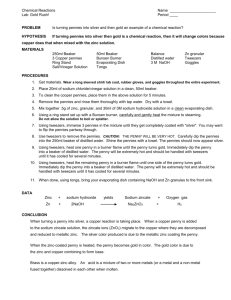Lab 3
advertisement
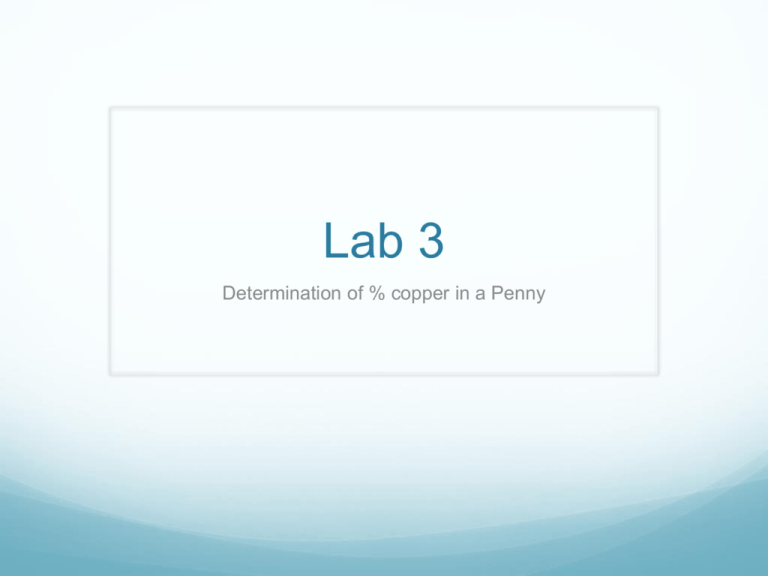
Lab 3 Determination of % copper in a Penny Purpose The U.S. government changed the composition of the penny coin in 1982. Pennies made before and after 1982 have different amounts of copper. The purpose of this experiment is to determine the percent of copper in pre-1982 pennies and post 1982 pennies. Background We saw in advanced lab skills that colored solutions absorb light. We are going to use this concept to determine how much copper is in our two pennies. In order to do this we must turn out penny into a liquid solution. Doing this requires very concentrated nitric acid that I WILL HANDLE. Mixing our copper penny with concentrated nitric acid results in a solution containing Cu+2 ions, nitrate ions, as well as Zn2+ ions (the other component of pennies is zinc) We have seen that neither NO3- nor Zn2+ absorb visible light (i.e. they have no color) Our resulting solution will be a light blue color, characteristic of Cu2+ solutions. In order to use the colorimeters to find the concentration of our penny we must first create a calibration curve. This calibration curve should be a straight line obtained by plotting concentration vs absorbance. Creating a Beer’s Law Curve The first step of your lab should be creating your graph. We need to use a stock solution to measure the absorbance of solutions of known concentration. You will be responsible for making this stock solution. I recommend you make 200 mL or 250 mL of a 0.4 molar CuSO4 solution. You should use this stock solution provided to you to make a series of carful dilutions. (The ratios are up to you but it might be a good idea to use the ones we used in Advanced Lab Skills) By graphing the absorbance of these solutions vs their concentrations you have created your Beer’s Law Curve. Using the Beer’s Law Curve When you graph the absorbance of your diluted solutions vs their concentration you should see a straight line. The equation of this line will be in y = mx + b form. Where y is the absorbance and x is the concentration. If you graph does not come out to a straight line you probably made a mistake and should start over. We then use the equation of the straight line to calculate the concentration of our unknown solution (x) by measuring its absorbance (y). Experiment Specifics Be very careful when making your stock solution. If the concentration of your stock solution is off all of your subsequent data and calculations will be off. Be very careful when making your dilutions. If you’re diluting at a ratio of 2 mL of stock to 8 mL of water make sure you are using EXACTLY 2 mL of stock and 8 mL of water. Remember the main goal of this experiment is to find out the percent of copper in our two pennies. So the most important step in this experiment is to… Once we dissolve our pennies and measure the absorbance of the resulting solutions how do we work that data to get the percent of copper in our pennies? Make sure you use distilled water to calibrate your colorimeter before you start your experiment. Make sure you always rinse your cuvette with the solution you are about to test. I would have all the dilutions prepared and the penny dissolved and diluted to 100 mL before you start taking any absorbance data. Make sure you have a complete data table. Analysis Questions 1. Show your calculations you used to create your stock solution. 2. Show your dilution calculations. 3. Show your Beer’s Law graph and equation. 4. Show your calculation for the concentration of Cu2+ in your 100 mL penny solutions. 5. Show your calculation for the mass of copper in your 100 mL penny solutions and the percent of copper in your two pennies. Conclusion Write a short paragraph highlighting the main parts of this experiment and the results. This should be a lot like your purpose section but with more detail. It should include specific numbers from YOUR DATA.
